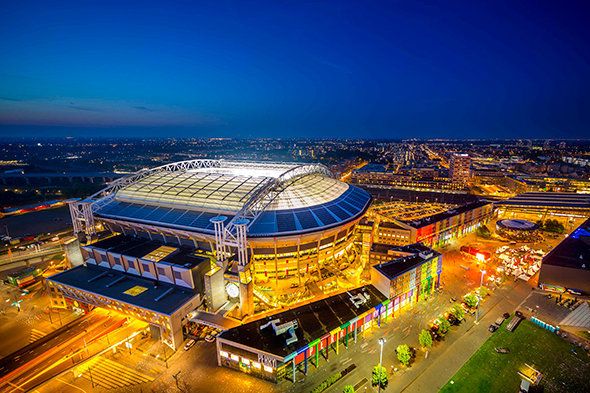Nothing can compete with the atmosphere of a packed sports stadium. We go in our millions every week to arenas around the world where we cheer on our team, or maybe sing-a-long to our favourite band. But while there might be plenty of energy coming from the fans, the stadium itself tends to consume it at huge rates.
To give you some idea, the electricity used by Wembley Stadium’s floodlights for one match in London is equivalent to watching 20,936 football matches on TV at home. Then there’s the waste to think about, with anywhere in the region of 10-15 tonnes of rubbish produced per game in most stadiums. And that’s before we get into the size and impact of the structure itself, the materials used in its construction, and the means by which people get to and from the venue.

Stadiums and the smart city
For some years now, architects, designers, engineers and ecologists have been radically rethinking the stadium to bring it in line with environmental recommendations and our changing attitudes towards the planet. What’s more, stadiums are central to the concept of the smart city.
In environments where Information and Communications Technology (ICT) and the Internet of Things (IoT) will increasingly play a part, stadiums will become providers as well as consumers, proxy power plants, storing and transferring energy that will be used elsewhere. This is a trend we’re already seeing in other large structures, like the PricewaterhouseCoopers building in London and the Bank of America tower in New York.
One of the biggest innovations and best examples of a stadium integrating into the smart city concept is the world-famous Amsterdam ArenA (pictured above), home to the legendary Netherlands side, Ajax. Nissan, power management company Eaton and The Mobility House have developed an energy storage system that makes the energy management of the Amsterdam ArenA more efficient, sustainable and reliable.
It makes use of repurposed batteries from Nissan’s EV car, the LEAF – 280 of them in total. These batteries are used for back up power but will ultimately replace the stadiums diesel generators, providing four Megawatts of power and four Megawatts of storage capacity. The technology to operate the system in this complex setup was developed by The Mobility House.
The batteries will also enable the stadium to power the surrounding neighbourhood and protect the grid from power-outs, providing a “huge advantage in sustainability” as Henk Markerink, the CEO of Amsterdam ArenA puts it, making it the “first stadium in the world that won’t be using fossil fuels anymore”.
“As Amsterdam ArenA, we asked a number of leading companies to come up with a proposal for our storage project,” Markerink says. “Nissan came with Eaton and The Mobility House with the best proposal. What we really liked was the fact that Nissan proposed construction LEAF batteries. That made it extra interesting proposal in terms of sustainability.”
Thomas Raffeiner founder and CEO of The Mobility House adds, “Together with Amsterdam ArenA, we chose Nissan/Eaton when receiving the highest quality car batteries and supporting the lifecycle character by using these batteries beyond the car’s life.”

Combining energy
Solar energy is often combined with other initiatives to form a patchwork of green solutions. The Allianz Riviera stadium in Nice, France, is a good case in point. Not only does it make use of a photovoltaic power plant consisting of 4,000 solar panels – enough to cover its energy needs – but a great deal of time has been spent thinking about ways to make it sustainable.
Wood features in its construction, a far more eco-friendly material, while a ventilation system channels wind through the structure to cool it naturally – a technique inspired by the Romans. What’s more, the stadium’s roof recovers and stores rainwater, which is later used to water the pitch.
Making use of water has been a preoccupation with designers involved in building the stadiums of the Qatar World Cup in 2022. With games likely to be played in temperatures above 100 degrees, how do you keep a stadium cool without using vast amounts of energy in the shape of air-conditioners?
The Sports City Stadium, due to be constructed on the eastern coast of Doha, proposes an ingenious solution: energy from an off-site solar farm will be used to heat up water, which is then transported to an on-site water storage tank.
This hot water runs through what’s called an ‘absorption chiller’ into another tank which pumps out air at 64 degrees, keeping the entire stadium at a temperature no higher than 80 degrees. Using such innovations, Qatar hopes to provide venues that are completely carbon neutral. In the future, this is certainly something we can expect to see more of in sports stadiums, especially those in hot climates.

Blending in
There is more to a stadium’s environmental impact than the energy it uses, and architects are increasingly becoming sensitive to how such structures interact with the landscape around them on a visual level.
The Estadio Chivas in Mexico recycles rainwater and harnesses wind power, but it also seeks to blend in with the local flora and fauna, which is the reason its outside walls are covered in grass. We can also can expect more stadiums like the proposed Stadium of Siena in Italy’s Tuscan countryside. It’s designed to be partially sunken into the landscape, enabling it to harmonise with the topography, as well as provide natural shade.
When it comes to eco-stadiums of the future, perhaps the most radical project thus far concerns the home of a small English football club you’ve probably never heard of. Forest Green Rovers play in the National League and are currently in the process of building the world’s first ever wooden stadium. Designed by Zaha Hadid Architects (ZHA), it will be made almost entirely out of sustainably sourced timber.
Ultimately, we can expect stadiums in the future to utilise all of the innovations mentioned above – power deriving from electric vehicle technology, eco-friendly builds and innovative tech in their infrastructure.
They may well exploit new materials (like bricks grown from natural cement by bacteria), and new technologies (such as walkways made of tiles that turn the fans’ footsteps into electrical power).
In the process, stadiums will become hubs integrated into the cities around them, helping to provide additional energy where it is needed. Certainly enough to get you off your seat in celebration.
Discover more about Nissan’s electric vehicle batteries and how they give homes, businesses and football stadiums access to safe, reliable and sustainable energy.